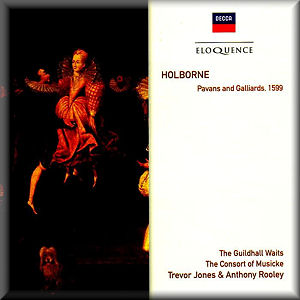 |
 |
|


alternatively
CD: MDT
|
Anthony HOLBORNE
(c.1545-1602)
Pavans and Galliards, 1599
Pavan (11) [03:26]
Galliard (12) [00:59]
Heres Paternus (33) [04:47]
Muy Linda (34) [01:11]
Infernum (21) [03:58]
Galliard (22) [01:11]
Paradizo (17) [02:35]
Sighes (18) [01:32]
The Image of Melancholy (27) [04:44]
Ecce quam bonum (28) [01:20]
Sic semper soleo (50) [01:23]
The Funerals (31) [04:32]
Galliard (32) [01:15]
Almayne (56) [01:03]
The Honiesuckle (60) [01:13]
As it fell on a holie eve (64) [00:57]
Heigh ho holiday (65) [01:02]
 The Guildhall Waits, The Consort of Musicke/Trevor Jones, Anthony
Rooley
The Guildhall Waits, The Consort of Musicke/Trevor Jones, Anthony
Rooley
rec. April 1980, Decca Studios, West Hampstead, London, UK. ADD
 DECCA ELOQUENCE 480 1802 [42:38]
DECCA ELOQUENCE 480 1802 [42:38] 
|
|
|
The 1970s and early 1980s were an exciting time for lovers of
early music in period instrument performances. Historical performance
practice was still in its formative years, and recordings with
authentic instruments were not all that common. So every new
initiative was welcomed with eagerness and curiosity. One such
which met great interest was L'Oiseau Lyre’s 'Florilegium' series.
Anthony Rooley and his Consort of Musicke were one of the pillars
of this series. Many recordings were released which put composers
on the map who until then were hardly more than names in a dictionary.
Some of them were included in concerts with music of the renaissance,
but John Dowland was probably the only composer of the English
renaissance to whom complete discs were devoted. That all changed
drastically with the emergence of the 'Florilegium' series.
Thanks to the Consort of Musicke complete collections of motets,
madrigals and consort music were released. All of a sudden the
likes of Thomas Morley, Thomas Tomkins, John Ward, John Jenkins
and Anthony Holborne became household names. The rich musical
heritage of the golden era in English music history - which
we now call the 'Elizabethan' and the 'Jacobean' eras - was
brought to life.
It can only be welcomed that these recordings are being reissued
again. I am not sure how many of them will appear, but many
deserve to be brought to the attention of music-lovers again.
Surprisingly some of the composers Rooley and his colleagues
paid attention to are still not frequently performed and recorded.
This disc is devoted to one of the most important publications
of instrumental music of the decades around 1600: the Pavans
and Galliards of 1599 by Anthony Holborne. In his foreword to
this reissue Anthony Rooley states that this recording "remains
the only integral recording of this important publication".
I find this rather puzzling: this disc is no "integral"
recording. Holborne's collection contains 65 pieces, and here
only 18 are selected. And since this recording was first released
several other recordings with music by Holborne have appeared.
As far as I know there is no recording of the complete collection.
Holborne's collection of Pavans and Galliards is well worth
being recorded in its entirety. It is very fine music, and typical
of its time. As Anthony Rooley writes various pieces reflect
no less the fashionable melancholy of the time than Dowland's
more famous oeuvre. In this collection it is in particular the
pavans which express this mood, as the titles indicate: The
Image of Melancholy, Pavana Ploravit (the Latin verb "plorare"
means "to weep"), and The Funerals. They are
usually followed by a more light-hearted galliard. The pavan
and the galliard, mostly written in pairs, were the most popular
dance-forms in England in Holborne's time. In this recording
they are always played in pairs, and the numbers between brackets
show that the connection between them is by Holborne himself.
The Consort of Musicke performs these pieces with two various
ensembles. Firstly the most common at the time: the consort
of viols. Secondly the consort of violins, which was mainly
the product of Italian musicians entering the country, and bringing
their violins with them. In addition, some pieces, among them
the last four, which are of a more joyful nature, are played
by The Guildhall Waits, a consort of cornetts and sackbuts,
with an additional curtal - an instrument which was called
dulcian in Italy. This combination of instruments was
usually used for outdoor performances, and it is not hard to
imagine that some of the more extraverted dances in the programme
may have been performed in the open air.
Since 1980 other recordings with pieces from this collection
have been released. One of them is the one by Hespèrion XX,
directed by Jordi Savall (Alia Vox, 2000). These performances
are more extraverted, and the sound of the viols is richer and
more colourful. But that recording is marred by questionable
scoring, for example the frequent addition of harpsichord and
even percussion. And taking into consideration that the present
recording is 30 years old it sounds remarkably fresh. All the
more reason to welcome it: the music is great and the interpretation
has survived the passage of time pretty well.
Fortunately the liner-notes of the original release have been
reprinted. Unfortunately the names of the musicians have been
omitted, although there was plenty of space in the booklet.
It seems to me a matter of justice to list them here: the violins
are played by Monica Huggett, Polly Waterfield, Trevor Jones,
Mark Caudle and Richard Webb, the viols by Trevor Jones, Alison
Crum, Oliver Hirsh, Gregor Anthony and Piet Stryckers, the virginals
and the lute (sparingly added to some items) by Alan Wilson
and Anthony Rooley respectively. The Guildhall Waits comprise
Jeremy West and Jonathan Morgan (cornett), Andrew Watts (curtal)
and Paul Niemann and Martin Pope (sackbut).
I sincerely hope more treasures from the old 'Florilegium' archive
are going to be reissued in the near future. This disc surely
whets the appetite.
Johan van Veen
|
|

